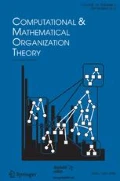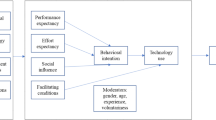Abstract
While previous studies on ambidexterity have focused on the antecedents or consequences of organizational ambidexterity, not many studies have attempted to explore ambidexterity at the individual level. This study intends to fill such gap and provides arguments on the effects of three different types of task assignment (exploration only, exploitation only, and both exploration and exploitation) on individual performance to understand ambidexterity. We adopted a single-agent simulation model and examined the relationship between the three types of task assignment and individual performance measured by the knowledge creation level. Individual attitude toward risk and tension between exploration and exploitation are considered in our simulation model. The findings suggest that the assignment of the ambidextrous task (both exploration and exploitation) generates the highest individual performance under some conditions, which negates the assumption that individuals find it difficult to handle both exploration and exploitation.





Similar content being viewed by others
References
Abernathy WJ, Clark KB (1985) Innovation—mapping the winds of creative destruction. Res Policy 14(1):3–22
Adler PS, Goldoftas B, Levine DI (1999) Flexibility versus efficiency? A case study of model changeovers in the Toyota production system. Organ Sci 10(1):43–68
Arrow KJ (1965) Aspects of the theory of risk-bearing. Helsinki, Yrjö Jahnssonin Säätiö
Bhatnagar R, Saddikutti V, Rajgopalan A (2007) Contingent manpower planning in a high clock speed industry. Int J Prod Res 45(9):2051–2072
Burgelman RA (2002) Strategy as vector and the inertia of coevolutionary lock-in. Adm Sci Q 47(2):325–357
Cao Q, Gedajlovic E, Zhang HP (2009) Unpacking organizational ambidexterity: dimensions, contingencies, and synergistic effects. Organ Sci 20(4):781–796
Chae SW, Seo YW, Lee KC (2015) Task difficulty and team diversity on team creativity: multi-agent simulation approach. Comput Hum Behav 42:83–92
Eiselt HA, Marianov V (2008) Employee positioning and workload allocation. Comput Oper Res 35(2):513–524
Floyd SW, Lane PJ (2000) Strategizing throughout the organization: managing role conflict in strategic renewal. Acad Manag Rev 25(1):154–177
Gibson CB, Birkinshaw J (2004) The antecedents, consequences, and mediating role of organizational ambidexterity. Acad Manag J 47(2):209–226
He ZL, Wong PK (2004) Exploration vs. exploitation: an empirical test of the ambidexterity hypothesis. Organ Sci 15(4):481–494
Heimerl C, Kolisch R (2010) Work assignment to and qualification of multi-skilled human resources under knowledge depreciation and company skill level targets. Int J Prod Res 48(13):3759–3781
Holmqvist M (2004) Experiential learning processes of exploitation and exploration within and between organizations: an empirical study of product development. Organ Sci 15(1):70–81
Jansen JJP, Tempelaar MP, Van DB, Volberda HW (2009) Structural differentiation and AMBIDEXTERITY: the mediating role of integration mechanisms. Organ Sci 20(4):797–811
Junni P, Sarala RM, Taras V, Tarba SY (2013) Organizational ambidexterity and performance: a meta-analysis. Acad Manag Perspect 27(4):299–312
Katila R, Ahuja G (2002) Something old, something new: a longitudinal study of search behavior and new product introduction. Acad Manag J 45(6):1183–1194
Kunz J (2011) Group-level exploration and exploitation: a computer simulation-based analysis. J Artif Soc Soc Simul 14(4):18. doi:10.18564/jasss.1798.
Lavie D, Stettner U, Tushman ML (2010) Exploration and exploitation within and across organizations. Acad Manag Ann 4:109–155
Levinthal DA, March JG (1993) The myopia of learning. Strateg Manag J 14:95–112
Lindley DV (1973) Making Decisions. John Wiley, London
March JG, Shapira Z (1987) Managerial perspectives on risk and risk taking. Manag Sci 33(11):1404–1418
McGrath RG (2001) Exploratory learning, innovative capacity, and managerial oversight. Acad Manag J 44(1):118–131
Mehlhorn, K., Newell, B. R., Todd, P. M., Lee, M. D., Morgan, K., Braithwaite, V. A., and Gonzalez, C. (2015). Unpacking the exploration–exploitation tradeoff: A synthesis of human and animal literatures. doi: 10.1037/dec0000033
Ming P (2010) Thriving in the New: implication of exploration on organizational longevity. J Manag 36(6):1529–1554
Mom TJM, Van DB, Volberda HW (2009) Understanding variation in managers’ ambidexterity: investigating direct and interaction effects of formal structural and personal coordination mechanisms. Organ Sci 20(4):812–828
Nembhard DA, Osothsilp N (2005) Learning and forgetting-based worker selection for tasks of varying complexity. J Oper Res Soc 56(5):576–587
Raisch S, Birkinshaw J (2008) Organizational ambidexterity: antecedents, outcomes, and moderators. J Manag 34(3):375–409
Raisch S, Birkinshaw J, Probst G, Tushman ML (2009) Organizational ambidexterity: balancing exploitation and exploration for sustained performance. Organ Sci 20(4):685–695
Ross SA (1981) Some stronger measures of risk aversion in the small and the large with applications. Econometrica 49(3):621–638
Sayin S, Karabati S (2007) Assigning cross-trained workers to departments: a two-stage optimization model to maximize utility and skill improvement. Eur J Oper Res 176(3):1643–1658
Sheremata WA (2000) Centrifugal and centripetal forces in radical new product development under time pressure. Acad Manag Rev 25(2):389–408
Smith WK, Tushman ML (2005) Managing strategic contradictions: a top management model for managing innovation streams. Organ Sci 16(5):522–536
Subramaniam M, Youndt MA (2005) The influence of intellectual capital on the types of innovative capabilities. Acad Manag J 48(3):450–463
Tushman ML, Anderson P (1986) Technological discontinuities and organizational environments. Adm Sci Q 31(3):439–465
Tushman ML, Oreilly CA (1996) Ambidextrous organizations: managing evolutionary and revolutionary change. Calif Manag Rev 38(4):8–30
Uotila J, Maula M, Keil T, Zahra SA (2009) Exploration, exploitation, and financial performance: analysis of s&p 500 corporations. Strateg Manag J 30(2):221–231
Wu MC, Sun SH (2006) A project scheduling and staff assignment model considering learning effect. Int J Adv Manuf Technol 28(11–12):1190–1195
Yoshimura M, Fujimi Y, Izui K, Nishiwaki S (2006) Decision-making support system for human resource allocation in product development projects. Int J Prod Res 44(5):831–848
Author information
Authors and Affiliations
Corresponding author
Rights and permissions
About this article
Cite this article
Hong, K., Yu, G.J. & Hyun, E. Understanding ambidexterity at the individual level: task assignment perspective. Comput Math Organ Theory 24, 34–50 (2018). https://doi.org/10.1007/s10588-017-9245-5
Published:
Issue Date:
DOI: https://doi.org/10.1007/s10588-017-9245-5




